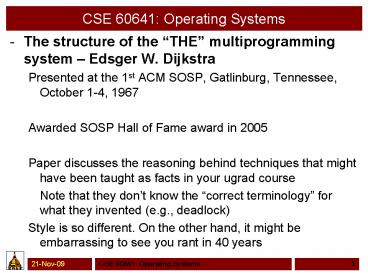The structure of the THE multiprogramming system Edsger W' Dijkstra PowerPoint PPT Presentation
1 / 6
Title: The structure of the THE multiprogramming system Edsger W' Dijkstra
1
CSE 60641 Operating Systems
- The structure of the THE multiprogramming
system Edsger W. Dijkstra - Presented at the 1st ACM SOSP, Gatlinburg,
Tennessee, October 1-4, 1967 - Awarded SOSP Hall of Fame award in 2005
- Paper discusses the reasoning behind techniques
that might have been taught as facts in your
ugrad course - Note that they dont know the correct
terminology for what they invented (e.g.,
deadlock) - Style is so different. On the other hand, it
might be embarrassing to see you rant in 40 years
2
What it talks about?
- Dijkstra describes his invention called
semaphores - They describe page relocation (so pages back from
drum/disk can go anywhere), virtual memory
(segmented memory is larger than physical memory) - They describe the need for clean interfaces and a
layered approach so that we can verify the
logical soundness of their design - They argue that with proper synchronization,
logical clocks can be used the physical clock
speeds are not relevant
3
Context
- Exciting times multiple processors, devices
(tape, tty) are becoming available. - a desire for multiprogramming though multiuser
systems are still far off. - a desire to get more out of the device so that we
can allow more users (perhaps commoditize
computing though the authors do not explicitly
say so) - a desire to bring order to systems software
development to manage complexity, bugs,
correctness etc.
4
How were their ideas relevant back then?
- Semaphores they over estimate the complexity of
managing semaphores. They assume that semaphores
encourage clean and provable systems. They
mention an unstable situation which we now
refer as unsafe and deadlocked - Layered approach they argue the some commercial
entities might not appreciate the simplicity
because their university system was just too
simple - Page relocation hard to imagine because machines
had so little resources (32K main, 512K disk) - How many processors did they have?
5
How are the ideas relevant now
- Layers approach - later became the monolithic
kernel vs microkernel/nano kernel argument. There
has been much work on debugging/managing OS
development. We are still not there yet - Semaphores undergrad OS students cannot escape
semaphores - Other systems ideas VM, relocation etc.
appropriate - What do we mean by now main frame, desktops,
laptops, PDAs, phones?
6
Discussion
- This paper is more than 40 years old. What do you
think is the state of the OS now?

